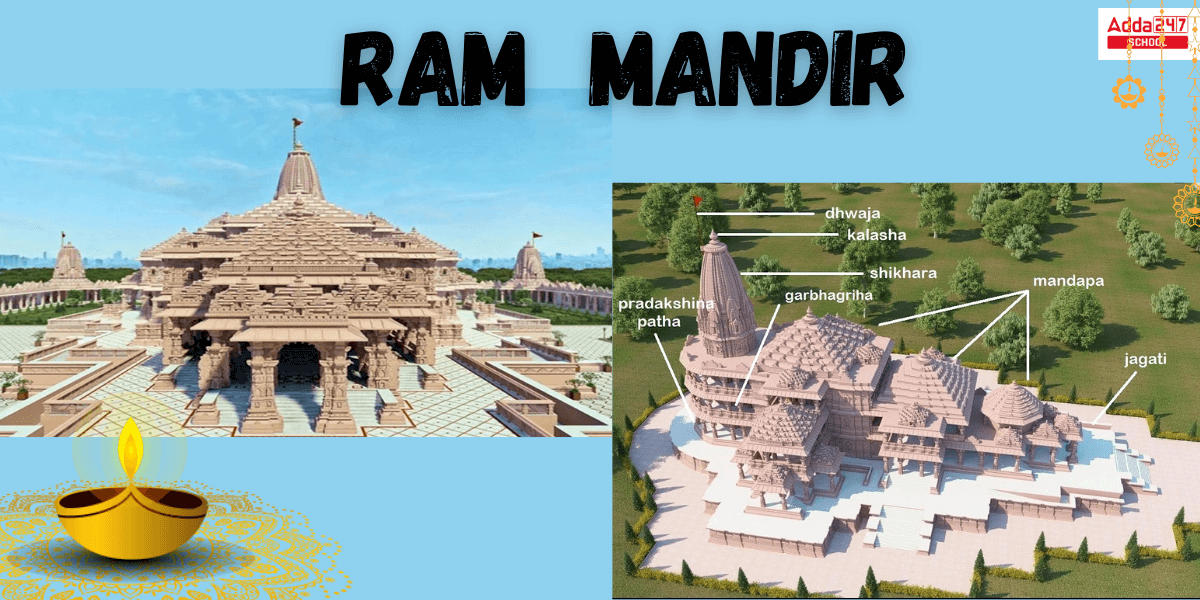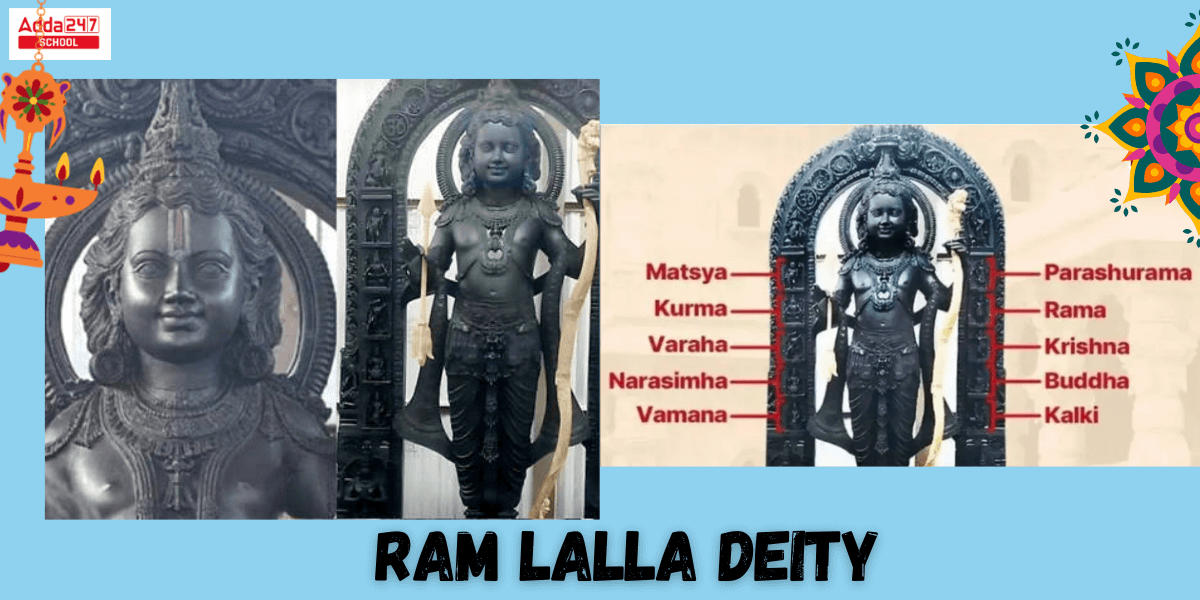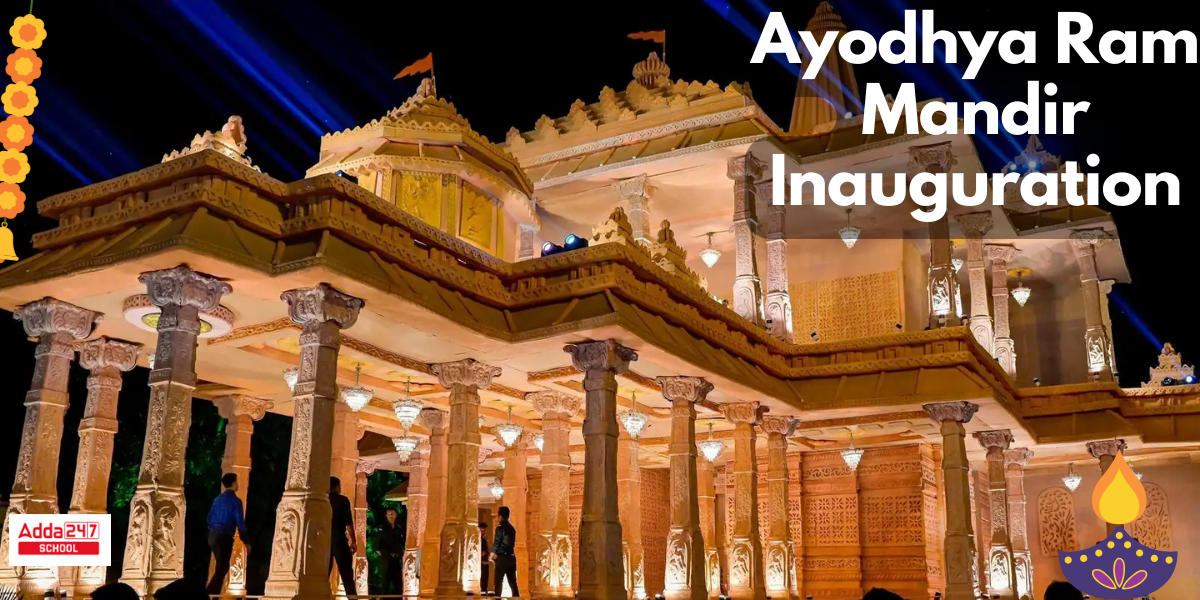Table of Contents
Ayodhya Ram Mandir
The ‘Pran Pratishtha’ ceremony of the “5-Year old RAM LALLA,” at the sanctum sanctorum of the new Ram Mandir is just one day away. The entire country, as well as tourists and pilgrims from other countries, look forward to the Grand Ram Mandir Inauguration at Ayodha in the Indian state of Uttar Pradesh.
The upcoming “Ram Mandir Inauguration” ceremony in Ayodhya is scheduled for January 22, 2024. Around 8,000 people will attend the celebration, including scores of officials from different political groups and officials from 55 countries. Many states, central governments, and private organizations have declared a public holiday or a half-day until 2 p.m. to mark this historic “Ram Mandir Utghatan” event.
Ayodhya Ram Mandir Event Schedule and Timings
10:45 a.m.: Arrival at Ayodhya helipad
10:55 a.m.: Arrival at Ram Janmabhoomi site
11 a.m.-12 p.m.: Reserved
12:05-12:55 p.m.: ‘Pran Pratishtha’ rituals begin
12:55 p.m.: PM Modi to leave the consecration ceremony venue
1 p.m.: Arrival at a public ceremony
1 p.m.- 2 p.m.: PM Modi to attend a public event in Ayodhya
2:10 p.m.: Visit to Kuber Teela. Arrival at a public ceremony
Ram Mandir Opening Date and Time
The countdown has begun for “Ram Mandir Uthghatan Anusthan”, the big day for all Ram devotees. Prime Minister Narendra Modi will arrive to lead the inauguration rituals. Ram Lalla is meticulously designated within the temple during this auspicious occasion between 12:15 and 12:45 p.m.
Pran Pratishtha Anusthan Timings
- The ceremony begins at 12:20 PM IST with a prayer to Lord Vishnu.
- At 12:21 PM IST, the priests begin reciting mantras to call upon Lord Rama’s presence.
- At 12:29 p.m. IST, the priests place Lord Rama’s idol in the temple’s sanctum.
- The ceremony concludes at 12:30 PM IST with a prayer to Lord Rama.
Aarti Timings on 22nd January
To take part in this historic event, Shri Ram Janmabhoomi Teerth Kshetra stated that individuals can make their Arti bookings online. It is also possible for enthusiasts to secure their Aarti passes through offline bookings in advance. Three aarti rituals are scheduled each day at 6:30 a.m., 12:00 noon, and 7:30 p.m. Aarti ceremonies will take place as follows:
- 6:30 a.m. IST : Shringar/Jagaran Aarti.
- 12:00 pm IST : Bhog Aarti.
- 7:30 p.m IST : Sandhya Aarti
What is Pran Pratishtha?
The term “pratishtha” refers to consecration. The term ‘pran’ represents life. “Pran or Prana pratishtha” is a respected Hindu ritual with significant meaning. The Prana Prathishtha ritual invokes a deity as an idol through mantras, rituals, and other steps.
In simple terms, pran pratishtha is the ‘creation of the life force in the deity.’ After completing the pran pratishtha ritual, the idol gains the ability to accept prayers and shower blessings on believers.
Pran pratishtha is thought to have long-term effects because the spiritual presence within the idol is said to last forever. It created a timeless bond between the devotees and the consecrated deity, instilling a sense of continuity in the holy place of worship.
7 day ‘Pran Pratishtha’ Rituals
The Pran Pratishtha celebration for the Ram Mandir in Ayodhya began on January 17 and will end on January 22, 2024. Let’s go over the 7-day ritual, in brief, day by day.
- The atonement ceremony, which included the ‘Dashvidh’ bath, Vishnu worship, and offerings to cows along the Saryu River, was conducted on January 16, 2024 led by Shri Ram Janmbhoomi Teerth Kshetra.
- The following day, January 17, a procession carried Ram Lalla (Lord Ram’s child-like) to Ayodhya, with devotees carrying Saryu water in Mangal Kalash on the route to the Ram Janmabhoomi temple.
- The formal rituals began on January 18 with Ganesh Ambika puja, Varun puja, Brahmin Varan, Matrika puja, and Vastu puja.
- ‘Navagraha’ and a ‘havan’ were established on January 19, after the lighting of the sacred fire.
- On January 20, the temple’s sanctum sanctorum (गर्भगृह) was washed thoroughly with Saryu’s holy water. Then Vaastu peace and Annadhivas practices took place.
- The January 21 ritual includes a divine bath with 125 urns, which culminates in Shayadhivas, where the Ram Lalla idol gets bathed and placed to rest.
- The celebration of January 22 will commence with an ‘aarti’ at 12:20 PM, after which there will be a morning puja and the consecration of the Ram Lalla deity in ‘Mrigashira Nakshatra’.
Ram Temple First Visuals
Here we have presented some spectacular visuals of Ram Mandir and Ram Lalla.


RAM Mandir Ayodhya Budget
- The BJP-led Central Government declared the formation of “Ram Mandir” in February 2020.
- The Shri Ram Janmabhoomi Teerth Kshetra Trust was tasked to oversee the construction and management of Ayodhya’s Ram Mandir.
- The Ram Mandir budget is approximately Rs 1,800 crore till 2024.
- More than Rs 3,500 crore in donations were received between February 2020 and February 2021.
- Champat Rai, secretary of the Shri Ram Janmabhoomi Teerth Kshetra Trust, previously stated that the temple cost Rs 900 crore to build between February 5, 2020 and March 31, 2023.
- He stated that the trust’s accounts still hold more than Rs 3,000 crore.
- Larsen & Toubro (L&T) and Tata Consulting Engineers are constructing and designing the Ram Mandir. The Indian Institute of Technology (IIT) has also guided them.
Ram Mandir Architecture
Lord Shri Rama temples have been built at Ram Janmabhoomi, the birthplace of Lord Shri Rama at Ayodhya, Uttar Pradesh.
- Style – The Ram Mandir architechture style is “INDIAN NAGARA”. The Nagara temple architecture style developed in northern India around the fifth century CE, during the late Gupta period. Nagara style is seen in contrast with the Dravida style of southern India, which emerged around the same time.
- Chief Artitechture – Chandrakant Sompura, 81, and his son Ashish, 51, created the complex in the Nagara style of temple architecture.
- Sculptors – The Sculptors are Arun Yogiraaj (Mysore), Ganesh Bhatt, and Satyanarayan Pandey
- Area – The temple’s total area is 70 acres, with 70% of that being green.
- Characteristics –The temple has three stories (floors), 392 pillars, and 44 doors.
- Asvisors –Design advisors for the temple include IIT Guwahati, IIT Chennai, IIT Bombay, NIT Surat, National Geo Research Institute Hyderabad, Central Building Research Institute Roorkee, and the National Institute of Rock Mechanics.
- Construction Company: Larsen and Toubro (L&T)
- Project Maneger – This project is managed by Tata Consulting Engineers Limited (TCEL).
- Temple Area: 2.77 acre.
- Dimensions – The Temple Dimensions are 380 feet long, 250 feet wide, and 161 feet high.
- Material – The use of steel or iron was entirely prevented in the construction of Ram Mandir. Traditional construction materials include Bansi Paharpur Pink Sandstone, White Makrana and Coloured Marbles, ‘Ram Shilas,’ Teakwood, Granite stones, and others.
Why is Lord Rama Temple so Important?
The conflict in Ayodhya revolved around control of a site that Hindus believe to be the birthplace of Lord Rama. After a decade of legal disputes in 2019, the Supreme Court of India issued its final decision in the case. Finally, they announced the establishment of the Ram Temple on the disputed site, and the court ordered the union government to establish a trust to handle and supervise the temple’s construction.
- Ayodhya has a strong historical and cultural connection to the Ramayana, an ancient Indian epic that is regarded all over the world.
- The Ram temple’s design is symbolic of India’s cultural heritage.
- The temple’s construction is viewed as fulfilling a long-standing spiritual and religious aspiration of the country’s Hindu population.
- The Ram Mandir project has the potential to promote economic growth in Ayodha. This sacred place will create lakhs of jobs, and boost tourism.
- The construction of the temple could result in the development of basic facilities such as roads in the region.
- The decades-long conflict over religion between Hindus and Muslims may come to an end once the Ayodhya dispute is resolved and Ram Mandir and a new mosque are built in the same location.





 Bihar Board 12th Result 2025 Out @ inter...
Bihar Board 12th Result 2025 Out @ inter...
 JEE Mains 2025 Session 2 Admit Card Out,...
JEE Mains 2025 Session 2 Admit Card Out,...
 Join ONE-Pro-Max - MAHAPACK for NEET-UG ...
Join ONE-Pro-Max - MAHAPACK for NEET-UG ...









